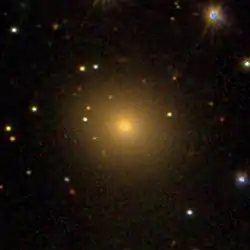| NGC 1283 | |
|---|---|
 SDSS image of NGC 1283. | |
| Observation data (J2000 epoch) | |
| Constellation | Perseus |
| Right ascension | 03h 20m 15.5s[1] |
| Declination | 41° 23′ 55″[1] |
| Redshift | 0.022439[1] |
| Heliocentric radial velocity | 6727 km/s[1] |
| Distance | 250 Mly (76.6 Mpc)[1] |
| Group or cluster | Perseus Cluster |
| Apparent magnitude (V) | 14.73[1] |
| Characteristics | |
| Type | E1[1] |
| Size | ~90,000 ly (27.5 kpc) (estimated)[1] |
| Apparent size (V) | 0.7 x 0.6[1] |
| Other designations | |
| CGCG 540-110, MCG 7-7-69, PGC 12478, UGC 2676[1] | |
NGC 1283 is an elliptical galaxy[2] located about 250 million light-years away[3] in the constellation Perseus.[4] The galaxy was discovered by astronomer Guillaume Bigourdan on October 23, 1884[5] and is a member of the Perseus Cluster.[6][5] It also contains an active galactic nucleus.[7]
See also
References
- 1 2 3 4 5 6 7 8 9 10 "NASA/IPAC Extragalactic Database". Results for NGC 1283. Retrieved 2018-07-07.
- ↑ "Your NED Search Results". ned.ipac.caltech.edu. Retrieved 2018-07-07.
- ↑ "NED Query Results for NGC 1283". ned.ipac.caltech.edu. Retrieved 2018-07-07.
- ↑ "Revised NGC Data for NGC 1283". spider.seds.org. Retrieved 2018-07-07.
- 1 2 "New General Catalog Objects: NGC 1250 - 1299". cseligman.com. Retrieved 2018-06-15.
- ↑ Brunzendorf, J.; Meusinger, H. (October 1, 1999). "The galaxy cluster Abell 426 (Perseus). A catalogue of 660 galaxy positions, isophotal magnitudes and morphological types". Astronomy and Astrophysics Supplement Series. 139 (1): 141–161. Bibcode:1999A&AS..139..141B. doi:10.1051/aas:1999111. ISSN 0365-0138.
- ↑ "NGC 1283". Retrieved 2018-07-07.
External links
 Media related to NGC 1283 at Wikimedia Commons
Media related to NGC 1283 at Wikimedia Commons- NGC 1283 on WikiSky: DSS2, SDSS, GALEX, IRAS, Hydrogen α, X-Ray, Astrophoto, Sky Map, Articles and images
This article is issued from Wikipedia. The text is licensed under Creative Commons - Attribution - Sharealike. Additional terms may apply for the media files.